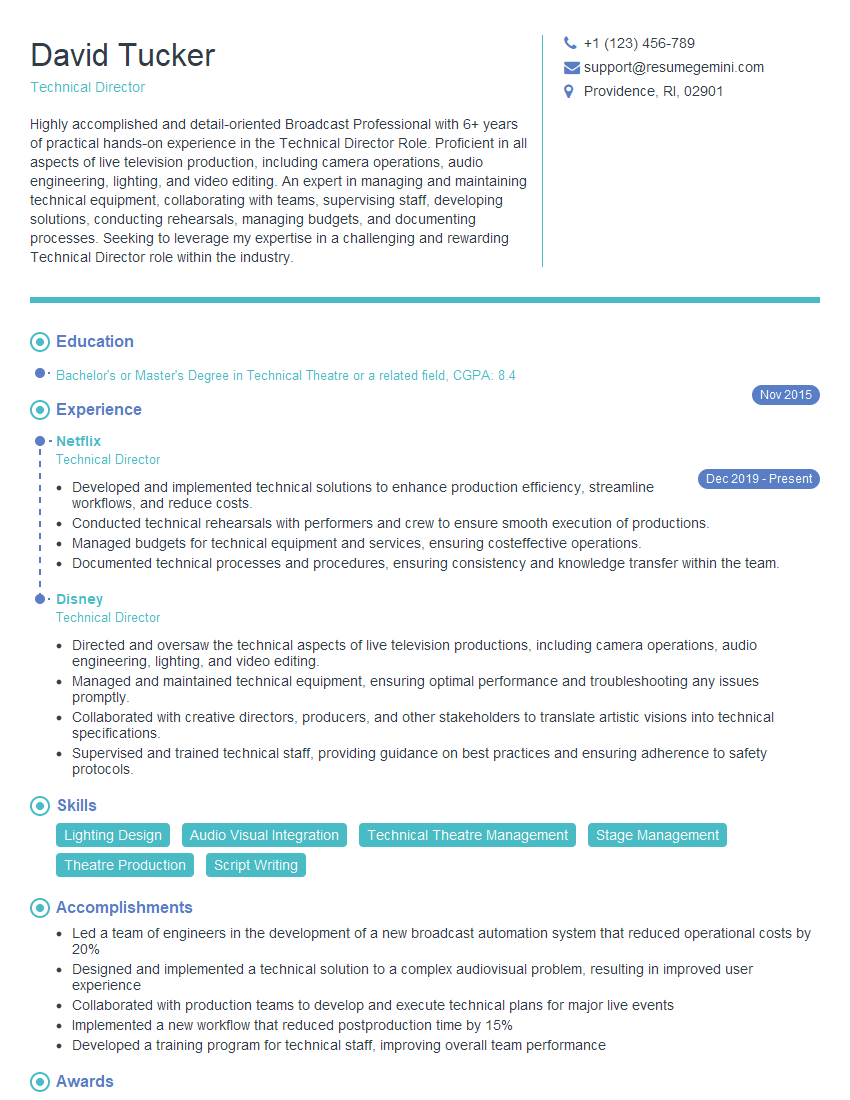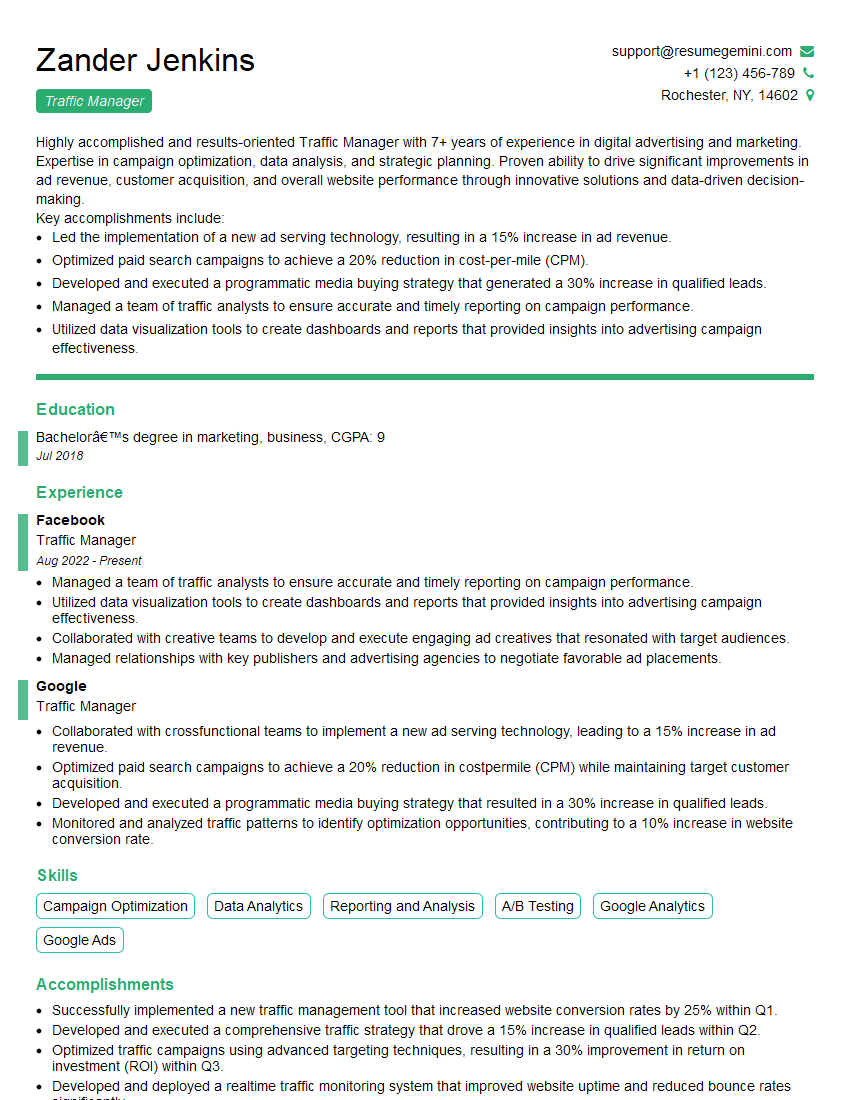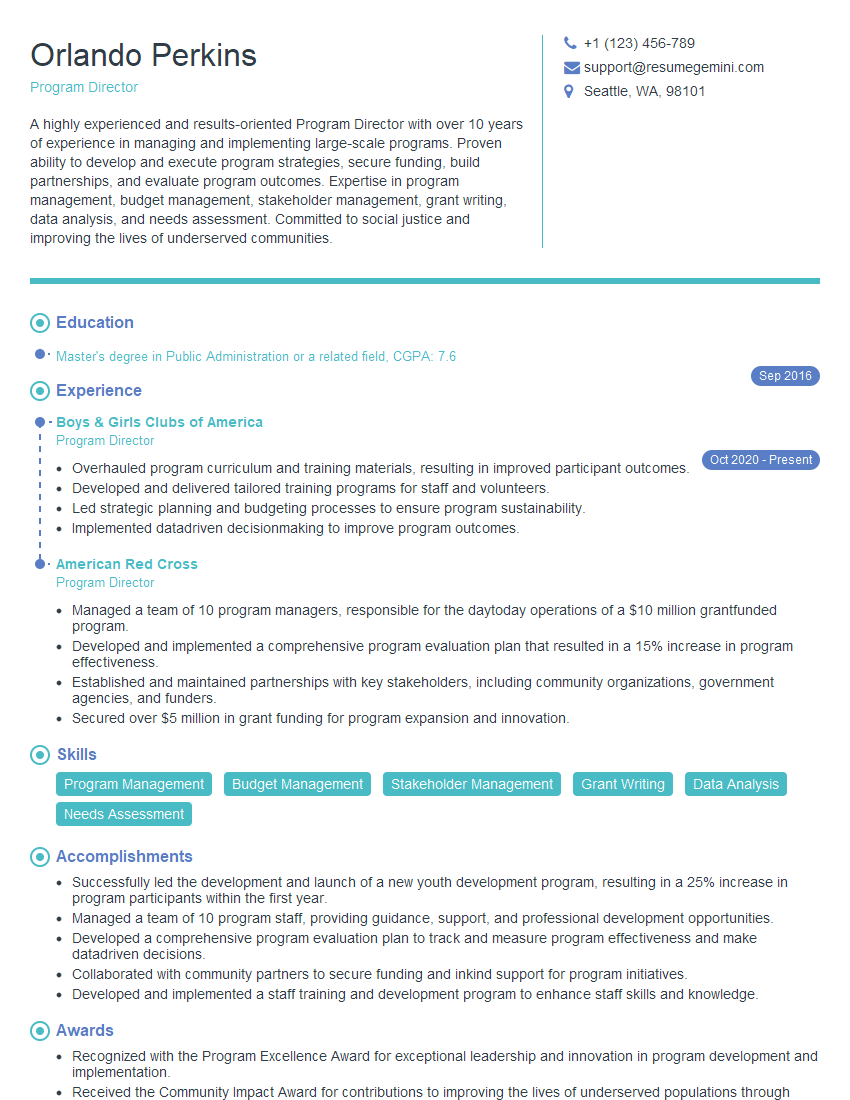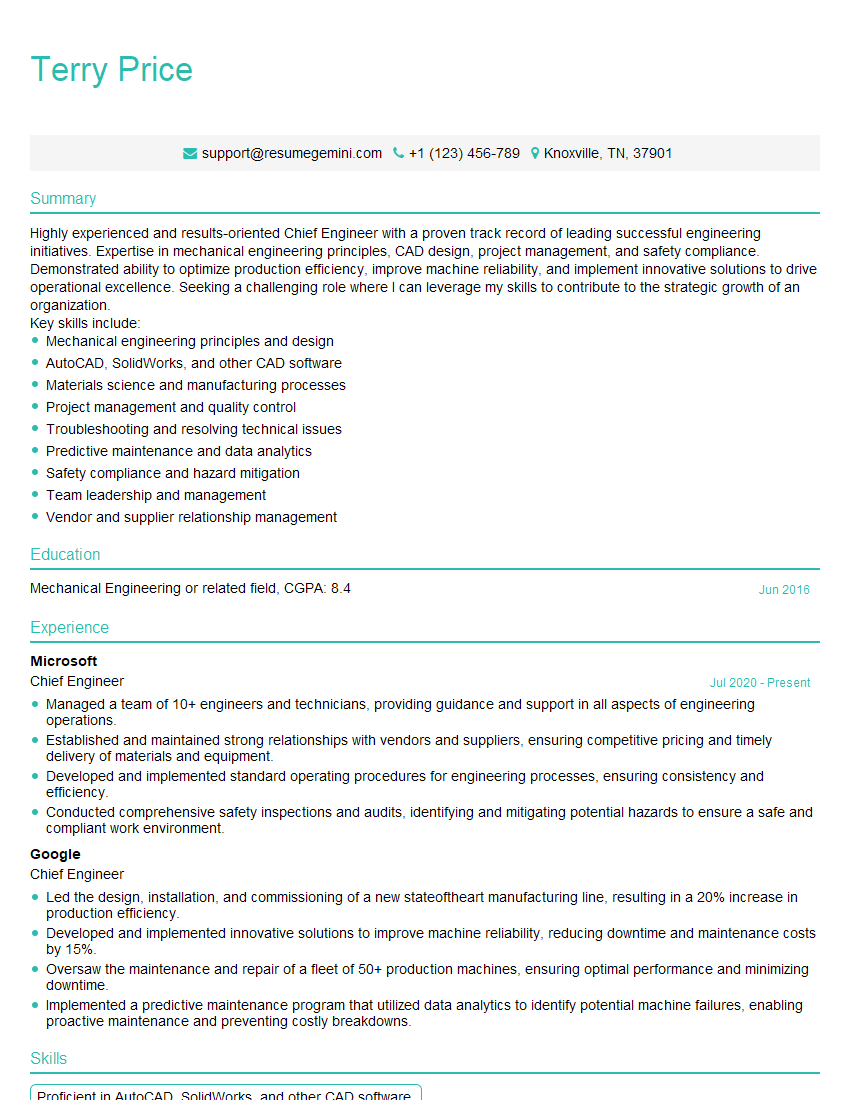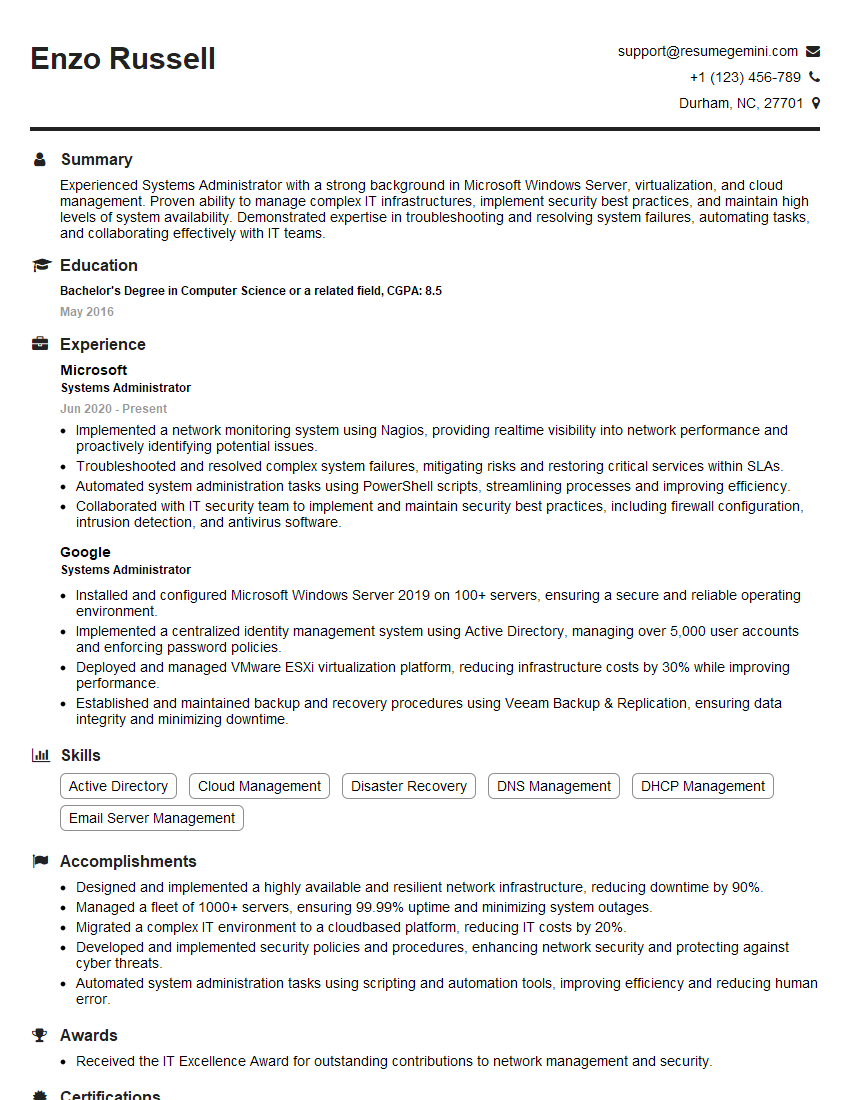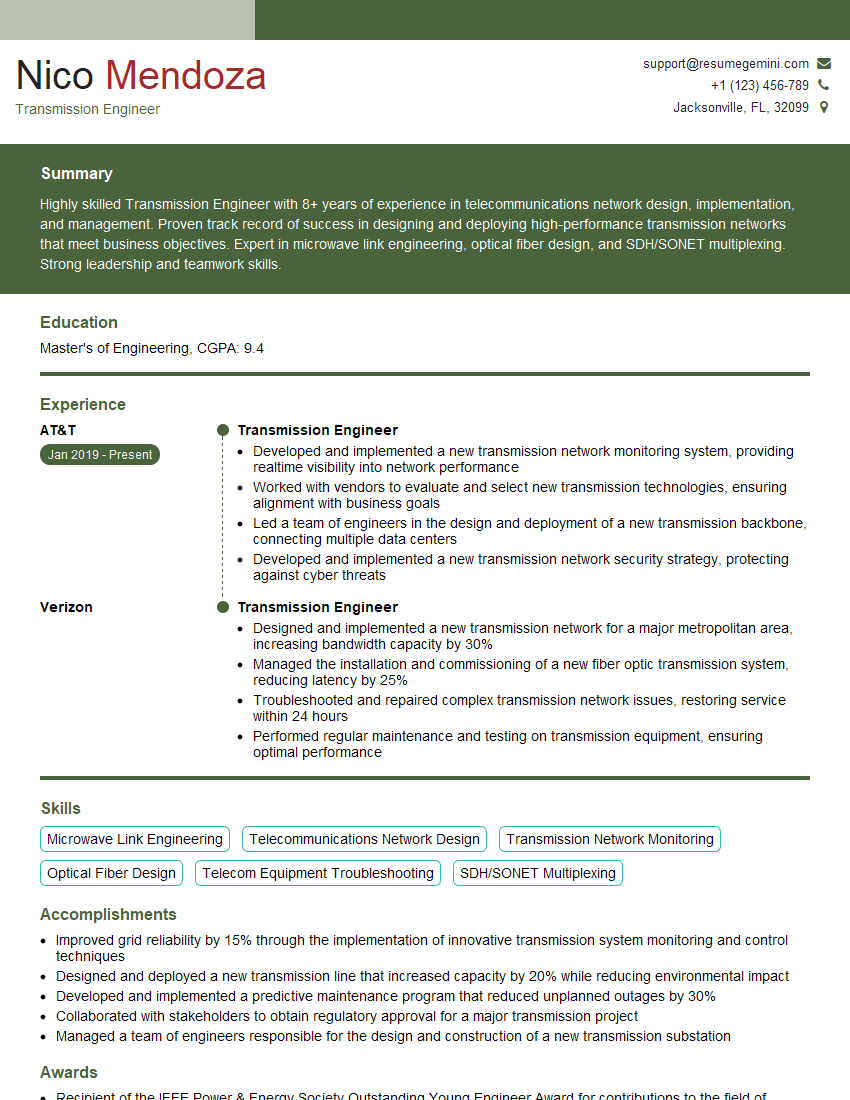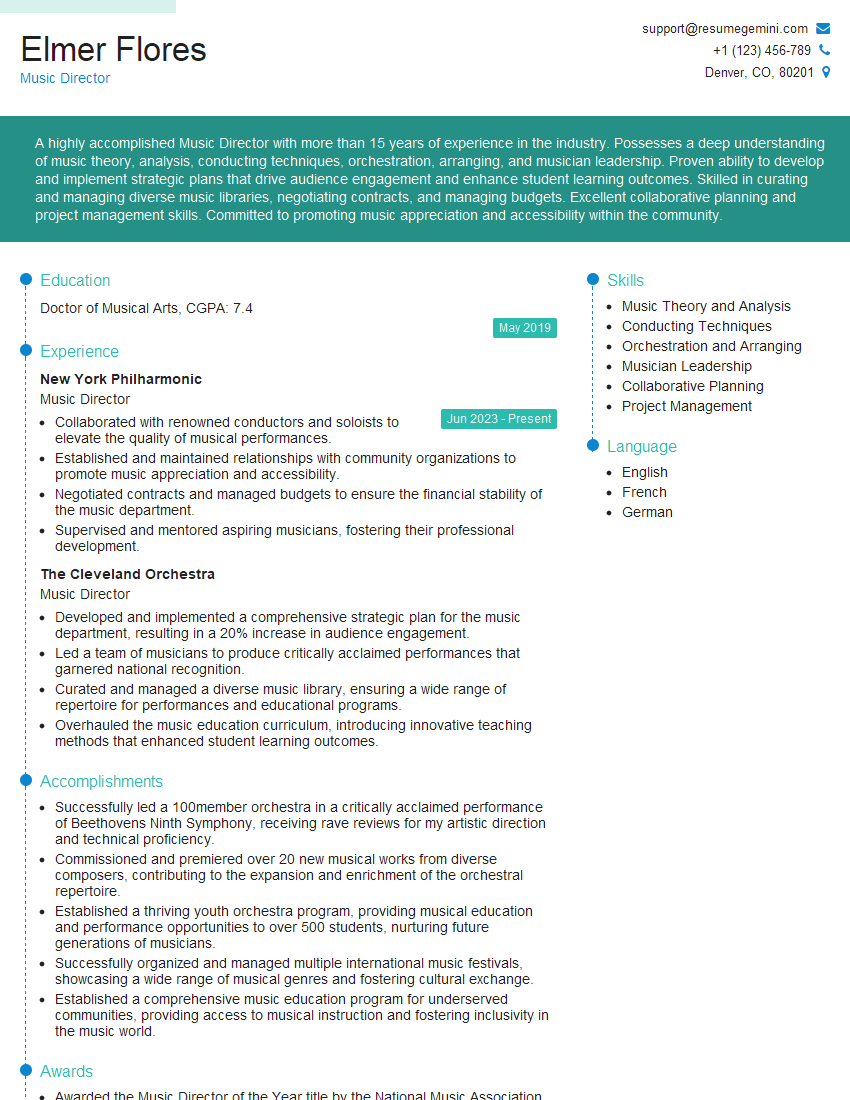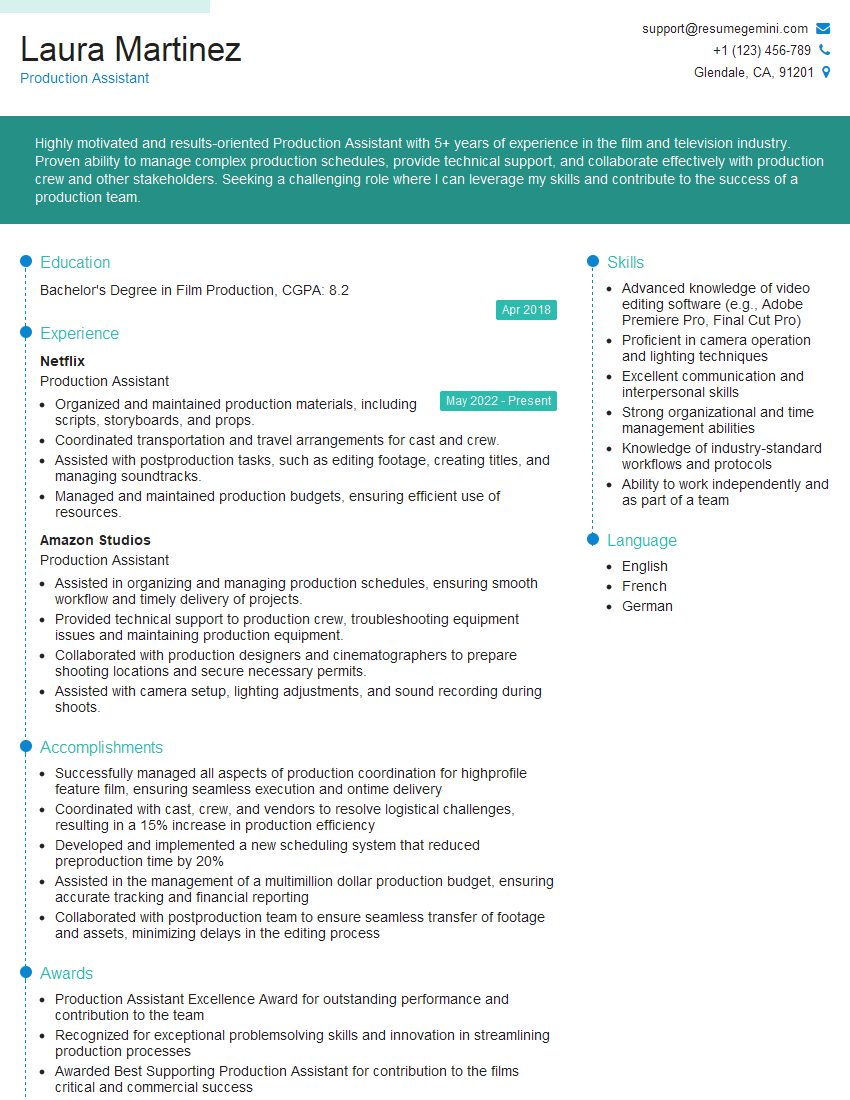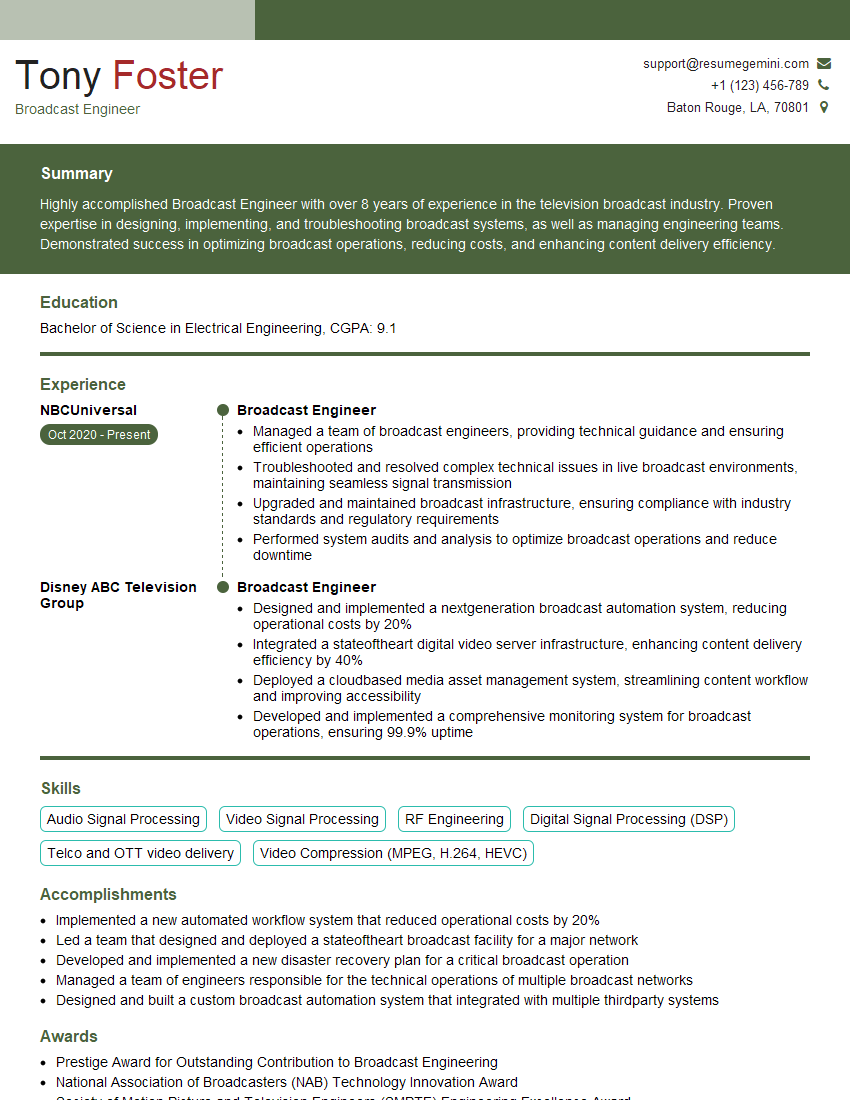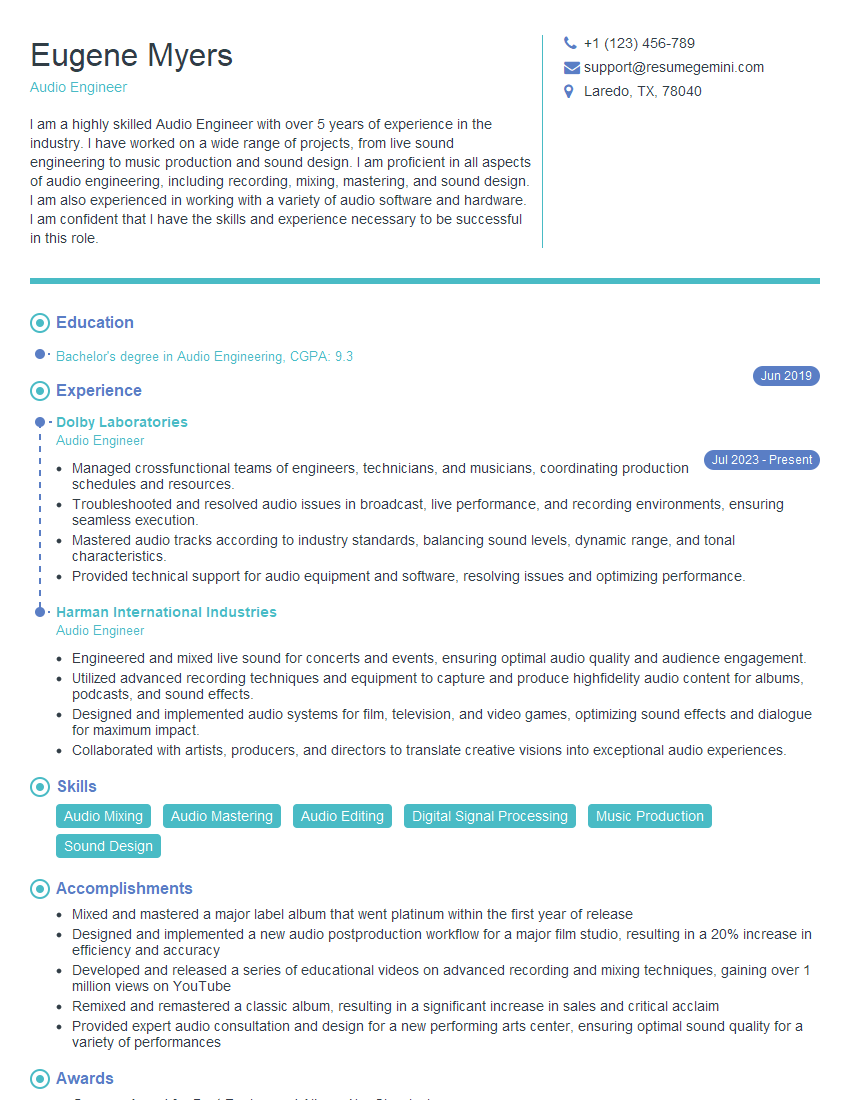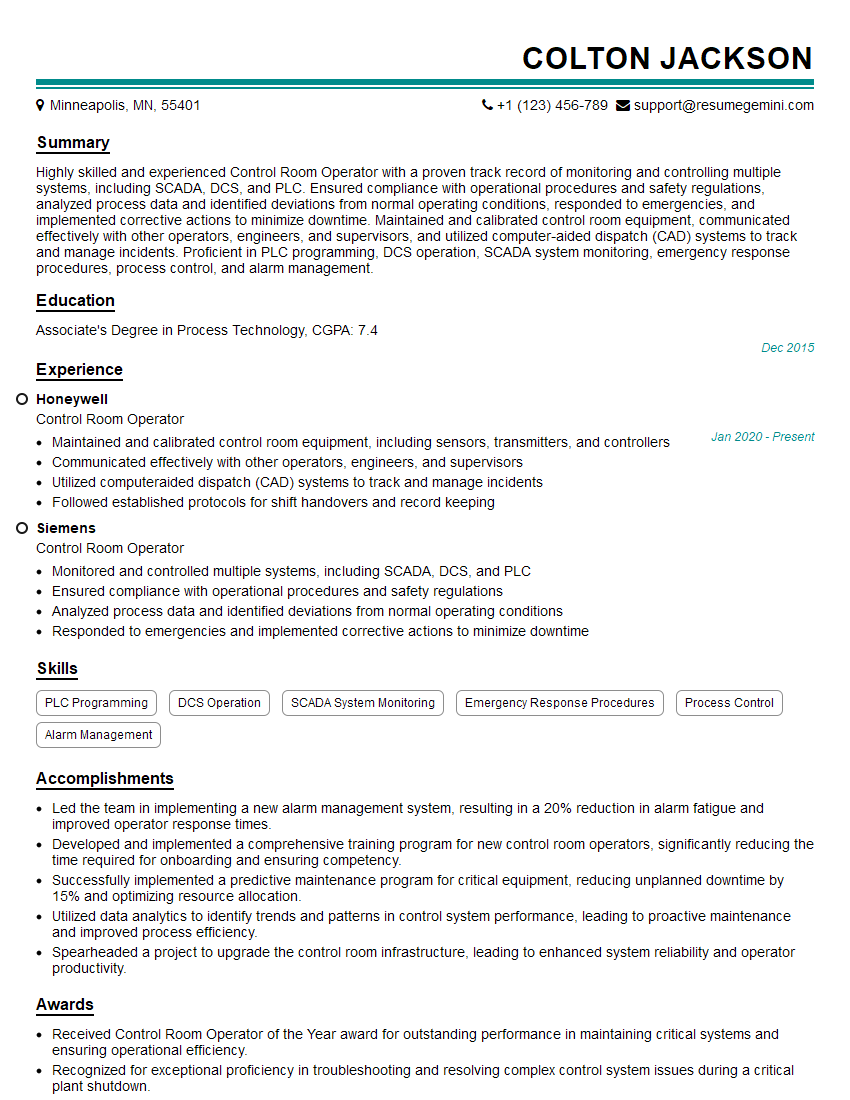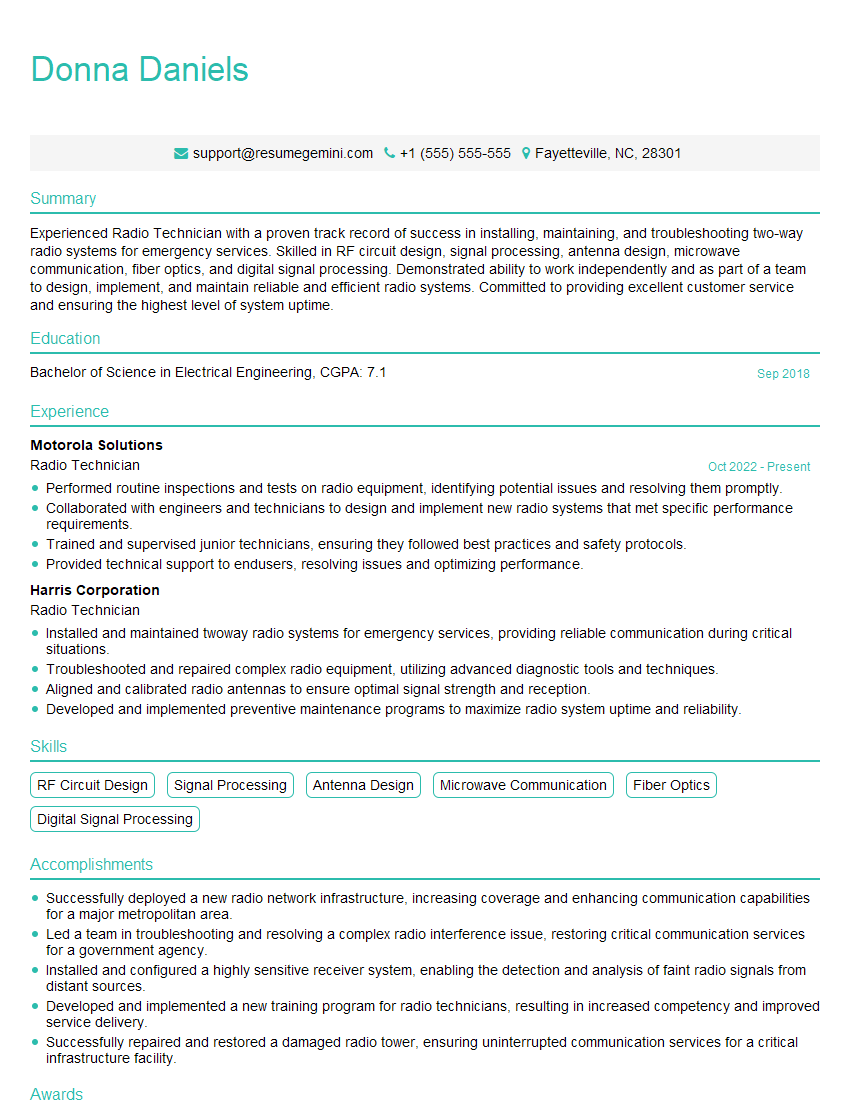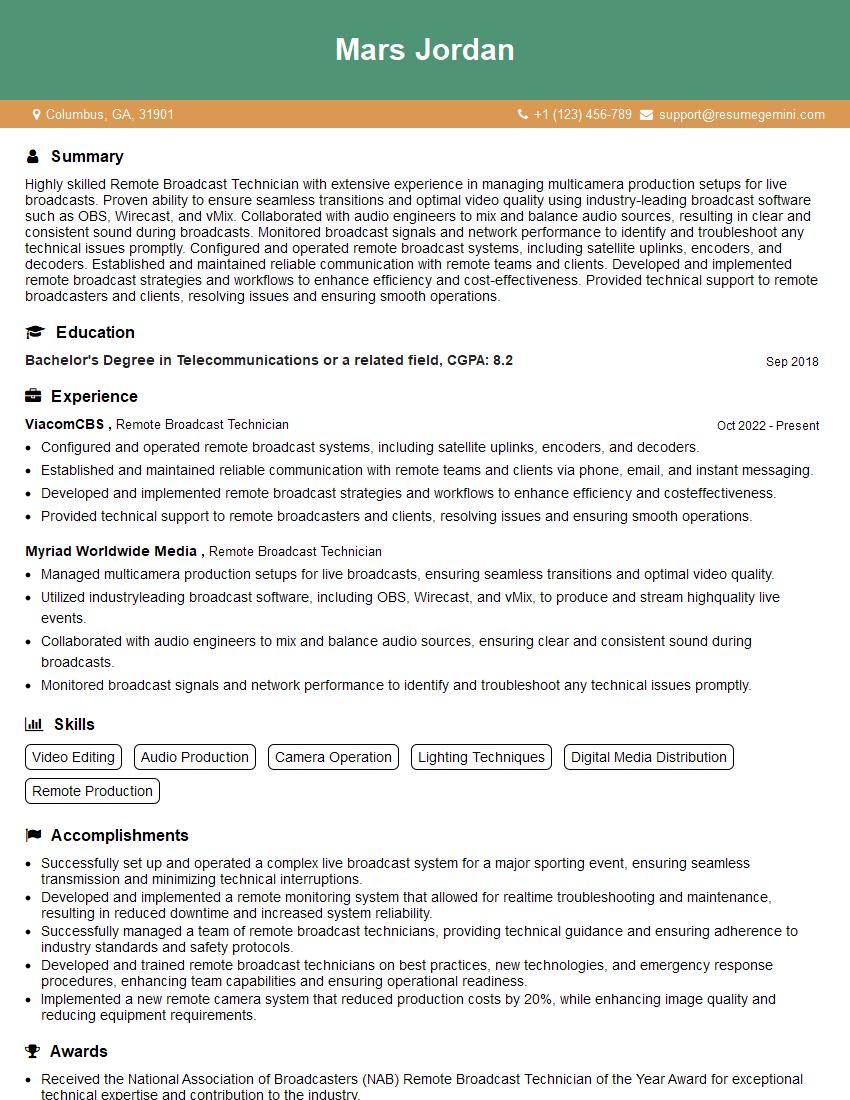Preparation is the key to success in any interview. In this post, we’ll explore crucial Radio Operations interview questions and equip you with strategies to craft impactful answers. Whether you’re a beginner or a pro, these tips will elevate your preparation.
Questions Asked in Radio Operations Interview
Q 1. Describe your experience with radio transmitter maintenance.
My experience with radio transmitter maintenance is extensive, encompassing preventative maintenance, troubleshooting, and repair. I’m proficient in working with various transmitter types, from low-power FM to high-power AM. Preventative maintenance involves regular inspections of all components, including the power supply, RF amplifier, and antenna system. This includes checking for overheating, loose connections, and degradation of components like capacitors and filters. Troubleshooting involves systematically identifying the source of a malfunction, which might involve using specialized test equipment like spectrum analyzers and signal generators to pinpoint problems with frequency stability, power output, or modulation. I’ve successfully diagnosed and repaired issues ranging from simple component failures to complex problems requiring adjustments to the transmitter’s tuning and alignment. For example, I once resolved a significant decrease in transmitter power by identifying a faulty high-voltage power supply capacitor, and another time pinpointed a harmonic distortion problem by carefully adjusting the transmitter’s filters. My approach emphasizes a thorough understanding of the transmitter’s schematic diagrams, and the use of safety procedures to avoid electrical shock and RF exposure.
Q 2. Explain the difference between AM and FM broadcasting.
AM (Amplitude Modulation) and FM (Frequency Modulation) are two different ways of encoding audio information onto a radio wave. In AM broadcasting, the amplitude (strength) of the radio wave varies according to the audio signal. Think of it like ripples in a pond – the height of the ripples represents the amplitude of the sound. In FM broadcasting, the frequency (pitch) of the radio wave varies according to the audio signal. Imagine a whistle – the pitch changes to represent different sounds. The key differences lie in their sound quality and susceptibility to noise. AM is simpler and cheaper to implement, but is more susceptible to static and interference from atmospheric noise and other radio signals. FM offers superior audio quality with less noise, producing clearer and crisper sound, because changes in frequency are less affected by outside interference. However, FM requires more complex equipment and a wider bandwidth. AM is often used for long-distance broadcasting due to its ability to diffract around obstacles, while FM tends to be used for local broadcasting.
Q 3. How familiar are you with various audio codecs and their applications in radio?
I am very familiar with various audio codecs and their applications in radio broadcasting. Codecs (coder-decoder) are crucial for efficiently compressing and decompressing audio signals, essential for digital audio broadcasting and streaming. Some commonly used codecs include MP3, AAC (Advanced Audio Coding), and Opus. MP3 offers a good balance between compression and quality but can produce artifacts at high compression rates. AAC provides generally better quality than MP3 at similar bitrates. Opus is a newer codec that offers high-quality audio at very low bitrates and is particularly suitable for streaming applications. The choice of codec depends on several factors, including the desired audio quality, bandwidth availability, and the target playback device. For example, a high-fidelity radio station might favor AAC or Opus for its high-quality audio, while a low-bandwidth internet radio stream might use a highly compressed MP3 codec to minimize data usage. I understand the trade-offs between bitrate, compression ratio, and audio quality for each codec.
Q 4. What troubleshooting techniques do you employ when dealing with audio signal issues?
Troubleshooting audio signal issues involves a systematic approach. My first step is to isolate the problem: Is the issue at the microphone, mixer, transmitter, receiver, or the antenna? I use a combination of visual inspection (checking cables and connections), listening tests, and using test equipment such as oscilloscopes, spectrum analyzers, and audio meters. If the problem is in the audio chain, I would start at the source (microphone) and work my way down, checking signal levels at each stage of the process. For example, if I detect a low signal level, I would check for faulty cables, inadequate microphone gain, or issues with the mixer’s input. If the problem is with distortion, I would check for clipping (overdriving the equipment) or other forms of signal degradation. Frequency response issues might indicate problems with equalization or filtering. I use signal tracing techniques and signal injection methods to quickly isolate the fault location. I also maintain detailed logs of equipment performance and maintenance activities to facilitate future troubleshooting.
Q 5. Describe your experience with studio equipment, including mixers, consoles, and microphones.
My experience with studio equipment is comprehensive. I am highly proficient in operating and maintaining various mixers, consoles, and microphones. I’m familiar with both analog and digital mixing consoles, understanding their routing, equalization, dynamics processing, and effects capabilities. I can configure and troubleshoot audio routing and signal flow within complex mixing environments. Regarding microphones, I have experience with different types – dynamic, condenser, ribbon – and understand their polar patterns and applications for various recording scenarios. For example, I know when to use a cardioid microphone for voiceovers to minimize background noise or a bidirectional microphone for interviews to capture both speakers equally. I can set up and adjust microphone gain, phantom power, and other parameters to optimize sound quality. My knowledge extends to audio interfaces, digital audio workstations (DAWs), and related studio hardware necessary for professional audio production. I am adept at using this equipment to create high-quality recordings for radio broadcasting.
Q 6. How do you ensure compliance with FCC regulations in radio broadcasting?
Ensuring compliance with FCC regulations is paramount in radio broadcasting. This involves adhering to strict guidelines regarding operating frequencies, power output, modulation, and emissions. We maintain meticulous records of transmitter operations, including frequency measurements, power output readings, and maintenance logs. We regularly conduct compliance testing, using specialized equipment to verify that our transmissions meet FCC standards. We also have procedures in place to handle unexpected events, such as equipment malfunctions, that could lead to non-compliance. Training is crucial for all personnel involved in operating and maintaining the broadcast equipment. I understand the importance of proper antenna installation and grounding to prevent interference and ensure signal integrity. We stay updated on all relevant FCC regulations and are proactive in implementing any necessary changes in our operating procedures to maintain ongoing compliance.
Q 7. Explain your understanding of audio processing techniques such as compression, equalization, and limiting.
Audio processing techniques like compression, equalization, and limiting are essential for shaping and improving the sound of audio signals for broadcasting. Equalization (EQ) adjusts the balance of different frequencies in an audio signal, allowing us to boost or cut specific frequencies to enhance clarity, warmth, or other tonal characteristics. For instance, boosting the high frequencies can improve the clarity of vocals, while cutting low frequencies can reduce muddiness in the mix. Compression reduces the dynamic range of an audio signal, making quieter sounds louder and louder sounds softer. This results in a more consistent volume level and a punchier sound. Limiting is a more extreme form of compression that prevents audio signals from exceeding a specified threshold, preventing distortion and protecting speakers. Think of compression as smoothing out peaks and valleys in a sound wave, while limiting is like a safety net that prevents the wave from going too high. Skillful use of these techniques requires a good understanding of audio principles and a keen ear to achieve a balanced and professional-sounding broadcast.
Q 8. What experience do you have with digital audio workstations (DAWs)?
My experience with Digital Audio Workstations (DAWs) is extensive. I’m proficient in several industry-standard DAWs, including Audacity, Adobe Audition, and Reaper. Beyond basic recording and editing, I’m comfortable with advanced techniques such as multitrack recording, mixing, mastering, and audio restoration. For instance, in a recent project, I used Audacity’s noise reduction tools to significantly improve the clarity of a field recording with considerable background hum, resulting in a broadcast-ready product. My skills extend to working with various audio formats and plugins, enabling me to tailor the sound to suit the specific needs of a broadcast, whether it’s a crisp and clear news bulletin or a rich and immersive soundscape for a drama program.
I understand the importance of efficient workflow within a DAW, using features like automation, grouping, and track management to ensure a streamlined and effective post-production process. For example, I’ve successfully managed complex projects involving dozens of tracks, meticulously organizing and processing audio to meet tight deadlines without compromising quality.
Q 9. Describe your experience with automation systems in radio broadcasting.
My experience with radio automation systems is comprehensive, encompassing both on-air and production-side functionalities. I’ve worked with a range of systems, including those from brands like Nautel and Wheatstone. I’m adept at programming automated schedules, integrating logging and metadata, managing playlists, and troubleshooting issues arising from system malfunctions.
For example, I successfully implemented a new automation system for a station transitioning from a fully manual operation. This involved migrating the existing music library, setting up automated traffic inserts, training staff, and ensuring a smooth transition with minimal disruption to broadcasting. My experience includes dealing with various automation system features, such as voice tracking, jingle insertion, and seamless integration with other broadcasting tools. I’m familiar with the importance of backup systems and disaster recovery planning for uninterrupted broadcast continuity.
Q 10. How do you manage multiple audio sources in a live broadcast environment?
Managing multiple audio sources in a live broadcast requires a combination of technical skill and organizational prowess. It’s akin to conducting an orchestra, where each instrument (audio source) needs careful balance and timing. I utilize audio mixers, both physical and software-based, to control individual source levels, apply effects, and route audio to the appropriate outputs. This involves understanding concepts like gain staging, equalization, and dynamics processing to achieve optimal audio quality.
In a typical scenario, I might be managing a live phone interview, studio microphone input, pre-recorded segments, and background music simultaneously. A key skill is the ability to quickly adjust levels to accommodate sudden changes in volume, ensuring a consistent and professional-sounding broadcast. The ability to anticipate potential issues, like feedback or interference, and having preemptive solutions in place are crucial. Clear communication with on-air talent regarding audio levels and cue points is also paramount.
Q 11. Explain your experience with IP audio networking and streaming protocols.
My experience with IP audio networking and streaming protocols is substantial. I’m familiar with various protocols like AES67, Ravenna, and RTP, and I understand their strengths and limitations. I’ve successfully integrated IP audio solutions in several broadcast environments, ensuring reliable audio transport over networks.
For instance, I configured a remote broadcast setup using AES67, allowing a reporter in the field to transmit high-quality audio to the studio seamlessly. This included network optimization, quality monitoring, and troubleshooting connectivity issues. Understanding QoS (Quality of Service) settings and network configuration is vital to prevent audio dropouts or latency. My skills also encompass troubleshooting network-related issues using tools like packet analyzers, ensuring the robustness and reliability of the IP audio infrastructure. Understanding the complexities of different codecs and their impact on bandwidth and audio quality is equally crucial.
Q 12. What is your experience with remote broadcast operations?
I have extensive experience with remote broadcast operations. This ranges from setting up and managing remote contribution feeds from reporters in the field to producing entire programs remotely. I understand the logistical and technical challenges inherent in remote broadcasting, such as maintaining consistent audio quality, managing latency, ensuring secure communication, and providing support for remote personnel.
I’ve successfully managed remote broadcasts using various technologies, including ISDN, codecs, and IP-based solutions. My experience includes working with remote control software to operate studio equipment from a distant location. A recent example involved coordinating a remote interview with a guest in a different time zone, requiring careful synchronization of schedules, equipment testing, and real-time troubleshooting. Understanding backup communication methods is crucial in handling unexpected technical issues or network failures during a remote broadcast.
Q 13. How do you handle unexpected technical issues during a live broadcast?
Handling unexpected technical issues during a live broadcast demands quick thinking, problem-solving skills, and a calm demeanor. It’s a situation that requires methodical troubleshooting, prioritizing solutions to minimize disruption to the program. My approach involves a structured process:
- Assess the problem: Identify the nature and severity of the issue. Is it a complete audio failure, a minor glitch, or a problem with a specific source?
- Implement immediate solutions: If possible, I switch to backup systems or sources immediately. This might involve switching to a spare microphone, selecting a different audio input, or utilizing a backup audio feed.
- Isolate the problem: If the issue is complex, I systematically investigate different components of the system to pinpoint the source of the problem.
- Communicate effectively: During the issue, clear and concise communication with on-air talent and technical staff is vital. Updating them on the situation and potential solutions ensures a coordinated response.
- Post-incident analysis: Following the broadcast, I conduct a thorough review to understand the root cause of the issue and implement preventative measures to avoid future occurrences.
For example, I once experienced a sudden loss of the main audio feed during a live sports broadcast. By quickly switching to a backup feed and communicating clearly with the announcers, we minimized disruption to listeners. A post-incident analysis revealed a faulty cable connection, which was subsequently replaced.
Q 14. What is your experience with broadcast monitoring and quality control?
Broadcast monitoring and quality control are crucial aspects of my role. I utilize various tools and techniques to ensure that the broadcast adheres to the highest standards of audio quality and regulatory compliance. This includes monitoring audio levels, identifying and correcting distortions or artifacts, and adhering to loudness standards.
I regularly use audio monitoring software and hardware to check for audio dropouts, distortion, noise, and other issues. My experience includes working with loudness metering tools and understanding relevant broadcast regulations, such as those set by the FCC (in the US) or Ofcom (in the UK). Proactive monitoring, regular equipment maintenance, and proactive problem-solving are essential for maintaining high quality standards throughout the broadcasting process. I also conduct regular testing and audits of equipment and systems to identify potential problems before they impact broadcasts. This proactive approach allows us to address issues and maintain a consistently high standard of output.
Q 15. How familiar are you with different types of antennas and their applications?
My familiarity with antennas is extensive. I understand that the choice of antenna is critical for efficient signal transmission and reception, depending greatly on frequency, terrain, and desired coverage area. Different antennas excel in different applications.
- Dipole Antennas: These are relatively simple, resonant antennas, often used in amateur radio and as elements in more complex arrays. Think of them as the basic building blocks. Their performance is highly dependent on their length relative to the wavelength of the signal.
- Yagi-Uda Antennas (Yagi Antennas): These are directional antennas known for their high gain and directivity, making them ideal for long-distance communication or point-to-point links. They’re commonly used in television reception and some professional radio applications.
- Parabolic Antennas (Dish Antennas): These highly directional antennas concentrate the radio waves into a narrow beam, perfect for satellite communication and microwave links. Their focusing capability allows for greater power density at the receiver.
- Helical Antennas: These are circularly polarized antennas often used in satellite communication and other applications where signal polarization is a critical factor. Their circular polarization helps reduce signal fading and multipath effects.
- Omnidirectional Antennas: These radiate signal in all directions, making them suitable for applications requiring wide area coverage, such as broadcasting to a city.
In my experience, selecting the correct antenna type involves careful consideration of technical specifications and the specific needs of the radio system. For instance, a high-powered broadcast station would require a different antenna compared to a low-power amateur radio station. Understanding antenna patterns, impedance matching, and gain is crucial for optimizing signal strength and reducing interference.
Career Expert Tips:
- Ace those interviews! Prepare effectively by reviewing the Top 50 Most Common Interview Questions on ResumeGemini.
- Navigate your job search with confidence! Explore a wide range of Career Tips on ResumeGemini. Learn about common challenges and recommendations to overcome them.
- Craft the perfect resume! Master the Art of Resume Writing with ResumeGemini’s guide. Showcase your unique qualifications and achievements effectively.
- Don’t miss out on holiday savings! Build your dream resume with ResumeGemini’s ATS optimized templates.
Q 16. Explain your knowledge of RF signal propagation and interference.
RF signal propagation is governed by many factors, including frequency, terrain, atmospheric conditions, and obstructions. Understanding how signals travel is vital for effective radio communication. Think of it like throwing a pebble in a pond – the ripples (signals) spread out, but their strength diminishes with distance.
Factors Affecting Propagation:
- Frequency: Higher frequencies generally experience greater attenuation (signal loss) and are more susceptible to atmospheric effects like rain fade. Lower frequencies can travel farther and penetrate obstacles better but offer less bandwidth.
- Terrain: Hills, buildings, and other obstacles can block or reflect signals, causing signal strength variations and multipath interference (signals arriving at the receiver via multiple paths).
- Atmospheric Conditions: Temperature inversions, humidity, and ionospheric activity can all affect signal propagation, leading to signal fading or enhancement.
Interference: Unwanted signals can interfere with desired signals, reducing clarity and reliability. Sources of interference include other radio stations, electrical equipment, and atmospheric noise. Minimizing interference involves careful frequency planning, antenna placement, and the use of filters and other signal processing techniques.
Example: A radio station operating near an airport may experience interference from the airport’s radar systems. To mitigate this, they might need to coordinate with the airport to avoid frequency conflicts or use directional antennas to minimize signal overlap. Careful site surveys and signal analysis are crucial for mitigating interference in practice.
Q 17. What is your experience with maintaining broadcast logs and records?
Maintaining accurate and comprehensive broadcast logs and records is crucial for compliance and efficient operation. These logs are a legal requirement in many jurisdictions and serve as a critical record of programming, technical operations, and any incidents.
My experience includes maintaining both paper and digital logs. These logs document:
- Program Schedule: Detailed information on the timing and content of each broadcast.
- Technical Information: Antenna performance, transmitter power levels, signal quality reports, and any equipment maintenance performed.
- Emergency Procedures: Records of any emergency procedures implemented, such as emergency alerts or station shutdowns.
- Incident Reports: Documentation of any technical malfunctions, signal disruptions, or other incidents that affected broadcast operations.
I’m proficient in using various logging software programs, ensuring data integrity and facilitating easy retrieval of information. Maintaining accurate logs is not only crucial for compliance but also essential for troubleshooting problems, analyzing performance, and continuously improving the broadcast operation.
Q 18. How do you prioritize tasks during a busy broadcast day?
Prioritizing tasks during a busy broadcast day requires a systematic approach. I use a combination of techniques to ensure smooth and efficient operations.
My approach involves:
- Emergency First: Addressing any critical issues, such as equipment malfunctions or broadcast interruptions, immediately.
- Time-Sensitive Tasks: Prioritizing tasks with deadlines, such as preparing for live broadcasts or news updates.
- Importance and Urgency Matrix: Categorizing tasks based on their importance and urgency. This helps focus on high-impact, time-critical tasks.
- Detailed Scheduling: Creating a schedule that accounts for all planned activities, leaving buffers for unexpected issues.
- Teamwork: Collaborating with colleagues to distribute tasks effectively and utilize individual expertise.
Example: If there’s a sudden power outage, restoring power becomes the top priority. Once that’s addressed, tasks like preparing for an upcoming show would follow, while routine maintenance tasks could be postponed if necessary. Effective prioritization ensures smooth operations and minimizes the disruption of broadcast programming.
Q 19. Explain your experience with power systems and backup generators for radio stations.
Reliable power is fundamental for uninterrupted broadcast operations. I have considerable experience working with both main power supplies and backup generators.
Understanding Power Systems:
- Main Power Supply: Ensuring a stable and sufficient main power supply is crucial. This includes regular checks of voltage levels and circuit breakers.
- Uninterruptible Power Supplies (UPS): UPS systems provide temporary power during outages, allowing for a graceful shutdown of equipment to prevent data loss or damage.
- Backup Generators: Generators are essential for ensuring continuous broadcasting during prolonged power outages. Regular maintenance, including fuel checks and testing, is crucial for ensuring reliability. Knowing how to start and operate the generator safely and efficiently is important.
- Power Distribution: Understanding the station’s power distribution system and ensuring adequate capacity for all equipment is crucial. This involves managing power loads and preventing overloads.
Practical Example: During a severe storm that caused a widespread power outage, I successfully initiated the backup generator, ensuring that broadcasting remained uninterrupted, thanks to previously scheduled and executed maintenance and tests of the backup power system. This experience highlights the importance of proactive planning and regular maintenance.
Q 20. Describe your experience with audio file formats and their compatibility.
My experience encompasses a wide range of audio file formats and their compatibility. Understanding the nuances of different formats is key to ensuring seamless integration and broadcast quality. Different formats are suited to different applications based on factors like audio quality, file size, and compatibility with broadcast equipment.
- WAV (Waveform Audio File Format): A lossless format, offering high-quality audio but with large file sizes.
- MP3 (MPEG Audio Layer III): A lossy compression format, smaller file size than WAV, suitable for online streaming or archiving.
- AAC (Advanced Audio Coding): Another lossy format, generally superior to MP3 in sound quality at similar bitrates.
- AIFF (Audio Interchange File Format): A lossless format, often used in professional audio production environments.
Compatibility: It’s essential to know which formats are compatible with our broadcast equipment and software. For instance, our broadcast automation system might only support WAV, AIFF, and MP3 formats. Converting files to compatible formats is sometimes necessary, a process requiring care to maintain audio quality. Incompatibilities can lead to playback errors, distorted audio, or broadcast disruptions.
Q 21. What is your experience with audio metering and loudness standards?
Audio metering and loudness standards are critical for consistent audio levels and listener experience. Inconsistent loudness can be jarring to listeners, leading to dissatisfaction. My experience involves using both analog and digital meters to monitor audio levels and ensure adherence to loudness standards such as the ITU-R BS.1770 recommendation and EBU R128.
Metering:
- Peak Meters: Measure the highest instantaneous level in the audio signal, ensuring it doesn’t exceed the limits of the system.
- Loudness Meters: Measure the integrated loudness of the audio signal, ensuring a consistent listening level across different programs and broadcasters.
- VU Meters: Analog meters that provide a visual representation of audio levels. These are increasingly replaced by digital meters which provide greater precision.
Loudness Standards: Adhering to loudness standards ensures consistent playback levels across platforms and devices. For example, exceeding loudness standards can lead to distortion or clipping, while being too quiet means that the audio might be difficult to hear. Accurate metering and loudness control is achieved through careful use of audio processing tools like compressors and limiters, ensuring consistent audio across our broadcasts.
Q 22. How familiar are you with different types of microphones and their polar patterns?
Microphone selection is crucial in radio broadcasting, directly impacting audio quality. Different microphones possess unique polar patterns that determine their sensitivity to sound from various directions.
- Omnidirectional: Picks up sound equally from all directions. Ideal for capturing ambient sounds or a large group of speakers, but susceptible to unwanted background noise.
- Cardioid: Most sensitive to sound from the front, rejecting sounds from the rear. This is a common choice for vocal work in a studio as it minimizes background noise.
- Supercardioid: A more directional version of a cardioid, providing even greater rejection of rear sounds, but with a slightly increased sensitivity to sounds from the sides. Suitable for situations with intense background noise.
- Hypercardioid: Highly directional, picking up sound from a very narrow area in front. Great for isolating a single sound source in a noisy environment, but requires precise microphone placement.
- Bidirectional (Figure-8): Equally sensitive to sound from the front and rear, rejecting sound from the sides. Useful for interviewing two people simultaneously, where sound from each needs to be captured.
For example, in a live outdoor broadcast, an omnidirectional microphone might be used to capture the atmosphere, while a cardioid microphone would be used for the presenter’s voice to minimize background noise from traffic or crowds. In a studio recording, a hypercardioid microphone might be used for precise capture of a single instrument to isolate it from the rest of the ensemble.
Q 23. Explain your understanding of signal-to-noise ratio (SNR).
Signal-to-noise ratio (SNR) is a crucial metric in radio broadcasting, representing the ratio of the desired signal’s power to the power of the unwanted noise. A higher SNR indicates a clearer, less noisy signal.
It’s expressed in decibels (dB) and calculated as: SNR (dB) = 10 * log10(Signal Power / Noise Power)
In practical terms, a high SNR ensures that the listener hears the broadcast clearly, without interference from hiss, static, or other unwanted sounds. A low SNR, conversely, leads to poor audio quality, making the broadcast difficult to listen to. For example, a broadcast with an SNR of 60dB is considered excellent, while one below 40dB may be significantly impaired by noise.
Maintaining a high SNR is achieved through various methods, including using high-quality equipment, employing proper signal processing techniques, and minimizing sources of interference.
Q 24. How do you ensure the security of your broadcast equipment and data?
Security of broadcast equipment and data is paramount. My approach involves a multi-layered strategy.
- Physical Security: Secure physical access to equipment rooms, studios, and transmission sites. This includes using locks, access control systems, and surveillance cameras.
- Network Security: Implementing robust firewalls, intrusion detection systems, and regular security audits to protect network infrastructure from unauthorized access and cyber threats.
- Data Encryption: Encrypting sensitive data, both in transit and at rest, to prevent unauthorized access or data breaches. This is especially crucial for protecting program schedules, financial records, and personal data.
- Access Control: Implementing strict access control policies to limit access to equipment and data based on roles and responsibilities. Passwords should be strong and regularly changed, and multi-factor authentication (MFA) should be implemented.
- Regular Updates and Maintenance: Keeping all software and firmware updated to patch security vulnerabilities promptly. Regular equipment maintenance ensures optimal performance and reduces the risk of malfunctions.
- Employee Training: Educating staff on security best practices, including password hygiene, phishing awareness, and the importance of reporting suspicious activity.
For instance, I would always ensure that our studio’s network is protected by a strong firewall and that all staff are trained to recognize and avoid phishing scams.
Q 25. What is your experience with scheduling and managing broadcast playlists?
I have extensive experience in scheduling and managing broadcast playlists using various software packages, including [mention specific software e.g., Zetta, Opus, etc.]. This involves:
- Planning and Organization: Creating detailed playlists, considering program formats, target audiences, and available resources.
- Scheduling: Allocating specific timeslots for programs, taking into account broadcast regulations, advertising slots, and special events.
- Music Curation: Selecting and sequencing music tracks based on style, tempo, and listener preference. This may involve using automated music scheduling tools, analyzing listener data, and adhering to music licensing agreements.
- Traffic Management: Coordinating the insertion of advertisements and promotional announcements into the broadcast schedule, ensuring that all materials are correctly formatted and delivered on time.
- Real-time Monitoring: Monitoring the on-air schedule to ensure that programs are running smoothly and addressing any unexpected issues or last-minute changes.
In a past role, I successfully managed the scheduling for a 24/7 radio station, implementing a new playlist management system that increased efficiency and improved listener engagement.
Q 26. How do you handle conflicts or disagreements within a broadcast team?
Conflicts within a broadcast team are inevitable. My approach emphasizes open communication and collaborative problem-solving.
- Open Dialogue: Encouraging team members to express their concerns openly and respectfully in a structured environment.
- Active Listening: Hearing all sides of the disagreement and actively trying to understand each person’s perspective.
- Mediation: Facilitating discussions between conflicting parties to find common ground and reach a mutually acceptable solution.
- Focus on Goals: Reminding the team of their shared objectives and emphasizing how resolving the conflict contributes to overall success.
- Documentation: Keeping records of the conflict and the resolution process for future reference.
For example, if there is a disagreement about the music selection for a specific segment, I would facilitate a discussion between the DJ and the music director, encouraging them to consider the target audience and overall program flow.
Q 27. Describe your experience with training and mentoring junior staff members.
I have a proven track record of successfully training and mentoring junior staff members in radio operations. My approach is personalized and hands-on.
- On-the-job Training: Providing practical, hands-on training in various aspects of radio broadcasting, such as operating equipment, producing shows, and adhering to broadcasting regulations.
- Mentorship: Offering individual support and guidance to junior staff, addressing their individual needs and challenges.
- Feedback and Evaluation: Providing regular constructive feedback, including both strengths and areas for improvement, in order to track progress and provide tailored assistance.
- Resource Provision: Sharing relevant resources such as training materials, industry best practices and relevant professional networks.
- Skill Development: Identifying training needs and providing opportunities for professional development, either through internal training sessions or external courses.
I have previously mentored a junior producer who, under my guidance, successfully produced and launched their own radio show. This involved coaching them on scripting, audio editing, and on-air presentation skills.
Q 28. What are your salary expectations for this position?
My salary expectations for this position are in the range of $[Lower Bound] to $[Upper Bound] per year, depending on the specifics of the role and the benefits package offered.
This expectation is based on my experience, skills, and the current market rate for similar positions in the industry. I am confident that my contribution will significantly exceed the value of this compensation.
Key Topics to Learn for Your Radio Operations Interview
- Broadcast Technology Fundamentals: Understanding different broadcast technologies (AM, FM, HD Radio, satellite radio), signal propagation, and transmitter operation. Consider practical scenarios involving troubleshooting signal issues.
- Studio Operations: Mastering audio mixing, microphone techniques, audio processing, and the operation of studio equipment (consoles, playout systems). Think about how you’d handle a live on-air technical problem.
- Programming and Scheduling: Familiarity with music scheduling software, playlist management, and understanding the principles of effective radio programming. Explore how you’d balance audience preferences with station goals.
- Regulatory Compliance: Knowledge of FCC regulations (or relevant local regulations) pertaining to broadcasting, licensing, and content. Consider scenarios requiring adherence to specific broadcast rules.
- Automation Systems: Understanding the operation and maintenance of radio automation systems, including troubleshooting and problem-solving. Explore the benefits and challenges of automated versus manual operation.
- Digital Media Integration: Familiarity with streaming platforms, social media integration, and the role of digital platforms in modern radio broadcasting. Consider how you’d leverage social media to enhance station reach.
- Emergency Alert Systems (EAS): Understanding the procedures and protocols related to EAS and other emergency broadcasts. This requires attention to detail and quick thinking under pressure.
Next Steps
Mastering Radio Operations opens doors to exciting career opportunities, from on-air talent to technical management roles. A strong understanding of these concepts is vital for career advancement and demonstrating your expertise. To maximize your job prospects, creating an ATS-friendly resume is crucial. ResumeGemini is a trusted resource to help you build a professional and impactful resume that highlights your skills and experience effectively. Examples of resumes tailored to Radio Operations are available to guide you in showcasing your qualifications. Invest the time to craft a compelling resume – it’s your first impression on potential employers.
Explore more articles
Users Rating of Our Blogs
Share Your Experience
We value your feedback! Please rate our content and share your thoughts (optional).
What Readers Say About Our Blog
Hi, I’m Jay, we have a few potential clients that are interested in your services, thought you might be a good fit. I’d love to talk about the details, when do you have time to talk?
Best,
Jay
Founder | CEO
